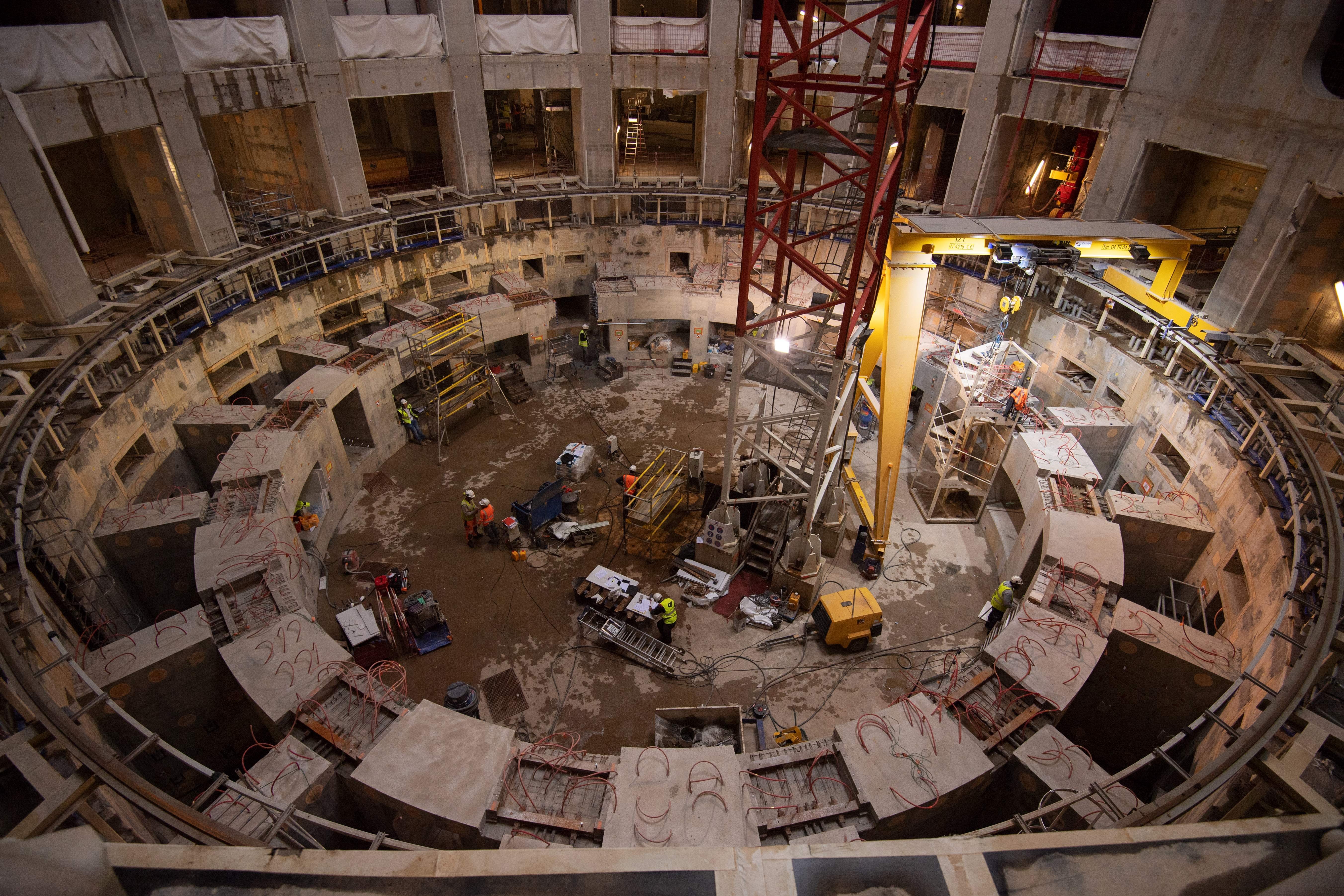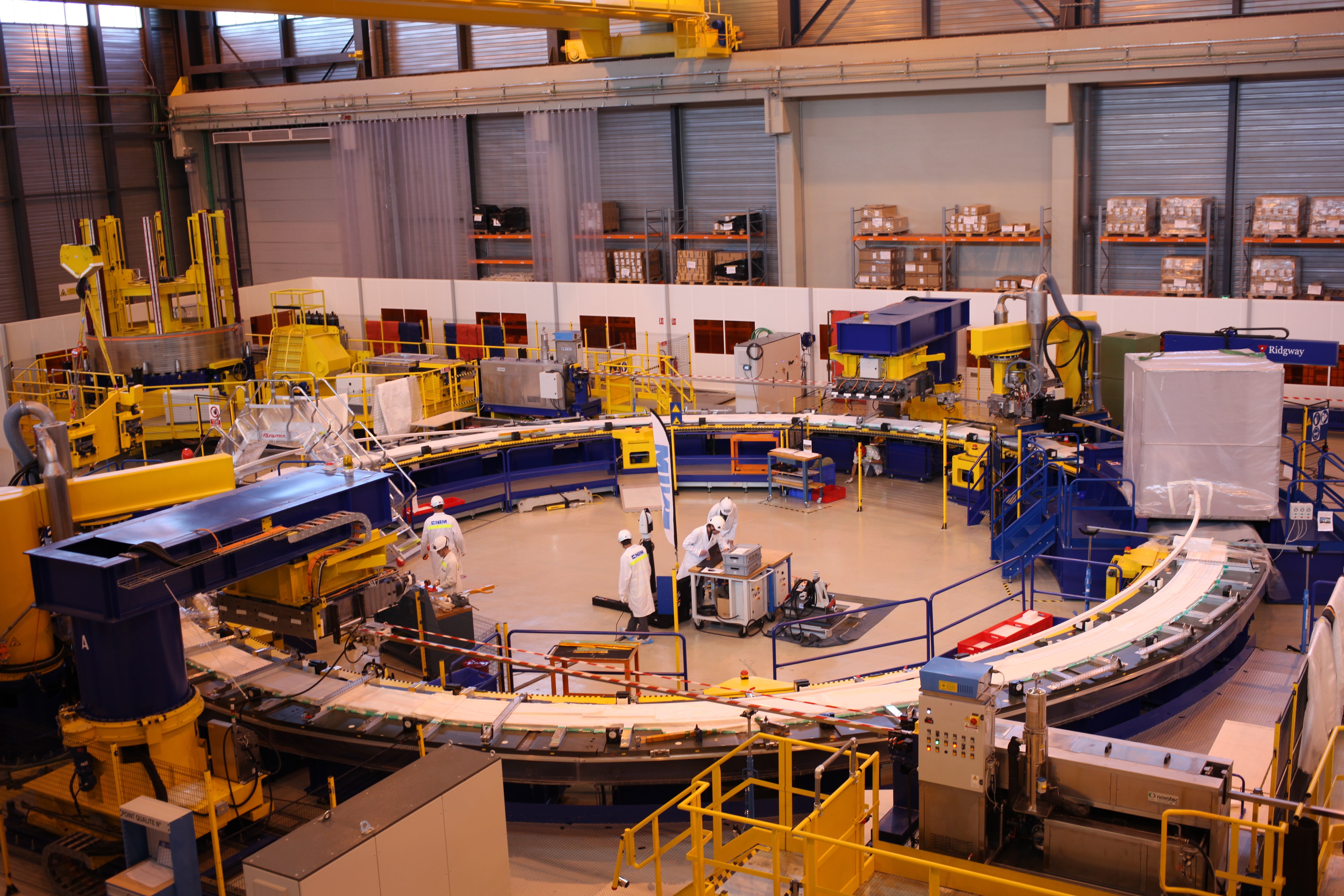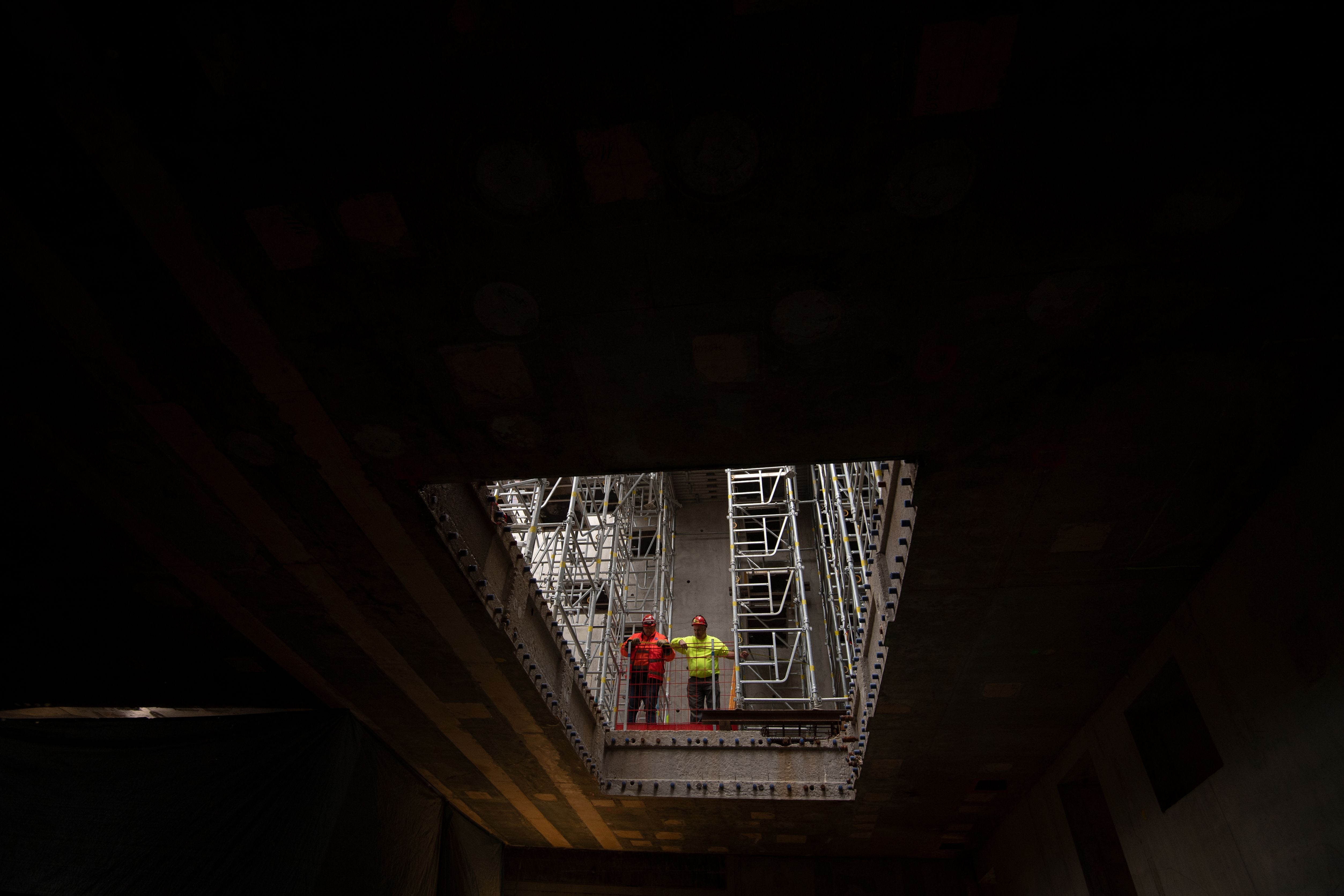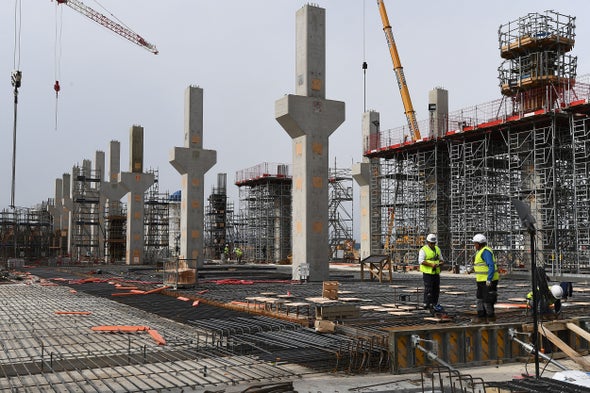The construction of the International Thermonuclear Experimental Reactor (ITER), the world’s largest nuclear fusion experiment, is now 60 percent complete. The challenges ahead are huge and the way to go is still long, but an extensive research effort is supporting the technological developments needed to make ITER a reality.
Saint-Paul-lès-Durance is a small, quiet village in the south of France, but the road leading there has been widened and reinforced to support large, heavyweight vehicles. Traveling in the dead of night to minimize travel disruptions, these heavy trucks are headed to the construction site of what will be the biggest fusion reactor in the world: the International Thermonuclear Experimental Reactor (ITER).
Nuclear fusion powers the sun. The principle is simple: two light nuclei combine to form a heavier nucleus and energy. The simplest fusion reaction to exploit involves two hydrogen isotopes, deuterium and tritium. Deuterium is abundant in sea water and tritium can be produced from lithium, thus a fusion plant would have no shortage of fuel. Moreover, it would not produce pollutants or radioactive waste and would be intrinsically safe, because fusion is not a chain reaction. Thus, fusion promises clean and sustainable energy.
.jpg)
The production of energy from fusion reactions has already been demonstrated in both tokamaks and stellarators, the two possible designs for a fusion reactor, but only in small research reactors that consume more energy than they produce. The next step is demonstrating that fusion can generate energy at the power-plant scale, and that is where ITER comes into play.
ITER, which uses a tokamak design, will be a research facility. Once completed it will produce 10 times the amount of energy it needs to operate, but no electricity. Despite its pivotal role, ITER will not be the end of the journey to fusion energy. It will set the stage for the construction of an industrial prototype, DEMO, which will convert the fusion energy into electricity and feed it to the electrical grid. “I don’t know how fusion will work at the industrial scale, but I want to find out. My expectation is that before the second half of the century we will be able to have some fusion power plants connected to the electrical grid,” explains Bernard Bigot, director general of ITER.

Heating plasma up
To trigger the fusion reaction, the electrostatic repulsion between the nuclei needs to be overcome until the strong attractive nuclear force kicks in. This is done by using extremely high temperatures: creating a plasma at 150 million degrees Celsius, 10 times the temperature of the sun.
The process starts with the injection of deuterium and tritium in the high-vacuum reaction vessel. An electric discharge separates the nuclei and electrons to create a light-density plasma. If the plasma touches the walls of the vessels it recombines and goes back to the gas phase, hence the importance of confining it with the help of ITER’s powerful magnets. The magnets are also used, along with radiofrequency and microwaves, to heat the plasma by exciting the ions. Further heating is achieved by the scattering of an injected beam of high-speed neutral deuterium.
The fusion reaction produces helium and neutrons with a higher kinetic energy than that of the original particles. Helium transfers some of its energy to the new hydrogen isotopes entering the vessel, so that the plasma is self-sustained. The chargeless neutrons escape from the magnetic confinement and transfer their kinetic energy to the walls of the vessel, generating thermal energy. In ITER this energy just heats up water, but in DEMO it will be transformed in electricity.
The timeline
Currently, around 60 percent of the construction work at ITER has been completed (Fig. 1). Once the facility will be operational, it will need to be carefully tested before it can reach full power. Thus, after the first plasma is produced, which is scheduled for 2025, it will probably take until 2035 to achieve full fusion power. By 2040 the construction of DEMO should start, and the connection to the grid is forecasted for 2060. After that, companies will hopefully take the lead in building fusion power plants, with limited involvement of the research community. “It’s a long way to go and this is why it is urgent not to lose even a single day,” says Bigot. “Think about the time it took from the first stream of oil to the oil industry: it was a century, and that was much simpler than fusion technology.”
The broader fusion landscape
ITER, a collaboration of seven members (China, the European Union, India, Japan, Korea, Russia and the United States) for a total of 35 countries, with the European Union responsible for nearly half of the project, is the flagship device in the fusion world; however, it is not an isolated effort. A strong research program exists to bring to maturity the technologies needed for ITER and DEMO and eliminate risks. For example, materials will be developed and tested as part of the international fusion materials irradiation facility project (IFMIF), for which engineering validation studies are underway in Japan, under the framework of the Broader Approach Agreement for the development of fusion energy between Europe and Japan. The resulting irradiation facility IFMIF-DONES (DEMO Oriented Neutron Source) might start operating in Europe in the next decade. The joint European torus (JET), a tokamak hosted in the United Kingdom that produced its first plasma in 1983 and is the most powerful fusion facility in use, is also providing an important test bed for materials and technologies for ITER.
Efforts to develop the technology behind the other possible fusion reactor design, the stellarator, are also underway. An experimental stellarator in Germany, Wendelstein 7-X, achieved the first plasma in 2016. “I think stellarators might also eventually succeed,” comments Juan Knaster, deputy head of Fusion for Energy, the organization that manages the European contribution to ITER. “They are one generation behind, but are very promising and future fusion reactors could be based on this design.”

Materials for extreme conditions
One focus of the fusion research and development program is on the materials that will be used for the reactor vessel. In this context, multiple challenges need to be addressed. First, the tiles lining the walls of the vessel will slow down the neutrons and transform their kinetic energy in thermal energy, thus they will need to sustain a very high heat load. Second, because the confinement of the plasma is not perfect, there can be interactions with the plasma: high-energy neutrons can erode materials, introducing impurities in the plasma that can stop the fusion reaction. Third, radioactive tritium could be retained by the material, making it radioactive as well. Last, the plasma is so hot that most materials would melt in its proximity.
Finding the right materials for ITER is thus no easy feat, and testing of materials in operating conditions is done at JET. When it was built, JET used carbon fiber composite tiles, but carbon binds with tritium, forming a powder that needs to be removed. In 2011, new tiles were installed in JET. The new tiles for the plasma-facing wall are made of beryllium, whereas those on the exhaust system at the bottom of the vessel, the divertor (a series of cassettes in which the impurities are collected to minimize plasma contamination) are made of tungsten.
Beryllium, apart from having exceptional thermal and mechanical properties, has the advantage that it does not absorb tritium. However, in the divertor, parts of the plasma actually touch the wall, thus even the very high heat resistance of beryllium is not sufficient for its coating; the material of choice is tungsten, which has the highest melting point of all metals and is resistant to plasma erosion. Tungsten is normally brittle, so procedures to mechanically process it to increase its strength and to alloy it with other materials to prevent its embrittlement from radiation damage are being studied.
The superconducting magnets
Substantial research effort also went into the design and production of ITER’s magnets, which are among the world’s largest and most technically sophisticated. ITER has three main magnet levels: the toroidal magnets are placed around the vacuum vessel to confine the plasma; the poloidal magnets are placed outside the toroidal system to shape the plasma, contributing to its stability; and a solenoid is placed at the center of the vacuum vessel and induces a powerful current in the plasma, heating it. Finally, there are correction coils that will compensate for possible small imperfections in the manufacturing and assembly processes. Because of the high magnetic fields that they need to generate (up to 13 Tesla), all ITER’s magnets are made of superconducting material—depending on the magnet, NbTi or Nb3Sn—and will operate at liquid-helium temperatures.

A million-pieces puzzle
Industry and research organizations are working together to manufacture the myriad components that will be part of ITER, fostering innovation and stimulating the development of technologies that might find applications beyond nuclear fusion.
The manufacturing of the components is distributed in all the 35 partner countries to ensure that they are all up to speed with the technological developments that will be needed when the time comes for a widespread use of fusion energy. “Huge pieces, more familiar in a shipyard, will need to be assembled with sub-millimeter precision: this is a big challenge,” observes Bigot. “The other challenge we have to face is the integration; we have to combine a lot of different technologies: vacuum, magnetism and heat transfer. The last challenge is to manage a collaboration of 35 different countries, which we are doing by ensuring a clear decision making process, profound integration of work and a reliable schedule.”
Many of the roughly 10 million components needed to assemble ITER are already on site. The first 310-tons toroidal field coil (from Japan) and the first 440-tons vacuum vessel sector (from Korea) are among the special deliveries expected in Saint-Paul-lès-Durance in 2019.
This article is reproduced with permission and was first published on May 21, 2019.


